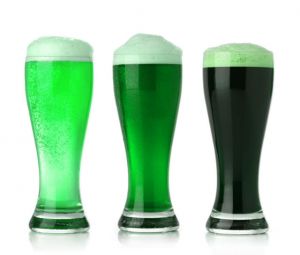
Saint Patrick’s Day: the holiday when even those who do not normally drink often decide to let loose for a night and enjoy beers and liquors galore. While we all know that drinking too much is dangerous and can lead to some severely negative consequences, some types of alcohol, when enjoyed in moderation, may actually provide a health boost.
The US Department of Agriculture (USDA) recommends no more than two drinks per day for men, and one drink per day for women. This equates to 12 ounces of beer, 5 ounces of wine or 1.5 ounces of hard liquor.
Now, we know that many people will exceed this on Saint Patty’s Day, however, if you do, be sure to listen to your body and not go overboard. Excessive drinking, even as a one-time occasion, can cause liver damage, severely impaired judgment and alcohol poisoning. Plus, you will be putting on a ton of empty calories.
When it comes to alcohol and health, not all drinks are created equal. The following is a brief synopsis of the pros and cons of common types:
Wine and champagne
This is the category of alcohol which can provide the most benefits to your health. Red wine, white wine and champagne are made from grapes, and provide a variety of heart-healthy, anti-inflammatory and anticarcinogenic antioxidants, as well as phenolic acid, which has been associated with boosting memory. Having a glass of wine per day may also help to lower cholesterol and assist with weight loss.
Red wine has a few added benefits. Its polyphenol antioxidants have been found to have especially notable benefits to the cardiovascular system, and can help prevent blood clots. The resveratrol found in red wine (this is what gives grapes their deep red color) is the subject of a body of recent research connecting it with anti-aging properties and improved memory, as well as lower blood sugar and blood pressure levels.
To get the most benefit from your wine, while avoiding chemical additives, choose organic varieties.
Beer
Surprisingly, beer has been found to have health benefits of its own. A drink per day of any kind of alcohol, including beer, is associated with reduction in heart disease risk. Beer may also help to reduce the risk of kidney stones, possibly thanks to its diuretic properties. It also contains some fiber, a few B-vitamins and silicon, which has been linked to stronger bones.
However, beer is usually quite high in carbohydrates, and is certainly not the best beverage of choice for your waistline. For those individuals who are gluten sensitive, most beers (both ales and lagers), as well as malt liquors, are a no-no, as they are chiefly made of wheat, barley or rye. Nowadays, many gluten-free varieties do exist, but be sure to check the label carefully.
Liquor
Hard liquors, including vodka, whisky and gin, provide the same cardiovascular benefits as wine and beer, provided that you keep it to a maximum of one (women) or two (men) 1.5-ounce portions per day. Certain liquors have been used traditionally for medicinal purposes; for example, gin for scurvy, or whiskey for preventing the common cold, but these benefits have not been well-researched.
Distilled liquors are gluten-free, as the distillation process eliminates the gluten from the grains used. However, some liquors have added flavorings that contain gluten, and if the liquor is not thoroughly distilled, it may contain gluten traces.
If you are worried about gluten, stick to high-quality, pure, thoroughly distilled liquors. The main downfall of hard liquor is it is very easy to go too far, and if you do not know your limits well, you could find yourself sick and stumbling in no time flat.
Mixed drinks
This is by far the worst kind of alcoholic beverage you can choose for your health. Many of these contain fructose and phosphate-laden sodas, and mixers with off-the-chart sugar content. For example, a traditionally made 4-ounce pina colada contains a whopping 28 grams of added sugars. Many additions to mixed drinks also contain artificial flavors, colors and chemical preservatives.
Mixed drinks that are made with liquor make it especially easy to ‘go overboard’, as the alcohol taste is often masked, and if you lose track of your intake you may wind up with dangerously high blood alcohol levels. Our recommendation is that if you’re going to have a drink, avoid mixed drinks altogether.
Going green
What about the famous Saint Patrick’s Day tradition of green beer, and green food? Artificial food colorings are certainly something to avoid when it comes to your health, as they are highly processed, and have been associated with behavioral issues in children. While the children, of course, will not be partaking in the green beer, green #3 (fast green), the most common green food coloring used, has also been linked to an increased risk of bladder and testicular cancer in rats.
 If you want to enjoy green beer without the green #3, simply add half a teaspoon to a teaspoon of spirulina powder to your drink. That way, you’ll enjoy the protein, vitamin and mineral content of this superfood algae along with its deep green hue.
If you want to enjoy green beer without the green #3, simply add half a teaspoon to a teaspoon of spirulina powder to your drink. That way, you’ll enjoy the protein, vitamin and mineral content of this superfood algae along with its deep green hue.
-The Alternative Daily
Sources:
http://healthyeating.sfgate.com/much-sugar-alcohol-6508.html
http://www.huffingtonpost.com/2012/03/16/st-patricks-green-food-health-risks_n_1349809.html
http://articles.mercola.com/sites/articles/archive/2011/02/24/are-you-or-your-family-eating-toxic-food-dyes.aspx
http://www.celiac.com/articles/222/1/Gluten-Free-Alcoholic-Beverages/Page1.html
http://healthyeating.sfgate.com/gluten-alcohol-5716.html
http://www.cnpp.usda.gov/Publications/DietaryGuidelines/2010/DGAC/Report/D-7-Alcohol.pdf
http://www.healthcentral.com/heart-disease/c/215658/161148/benefits-champagne
http://www.eatright.org/Public/content.aspx?id=6442463947
http://www.foodrepublic.com/2012/08/23/10-things-you-didnt-know-about-gin

